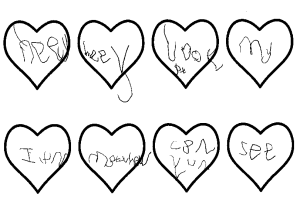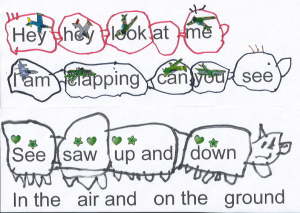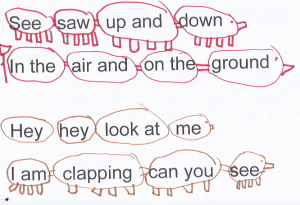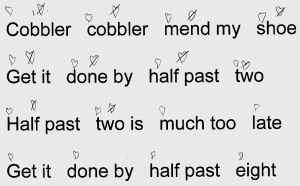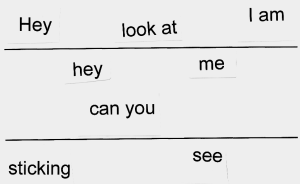Once my students have achieved the Solfa Challenge Level 2 they should be able to perform a collection of simple songs and rhymes, show the pulse and shape of the pitch and also record these two things in a fairly rough and ready way. In Level 3 we will expand on this and start to introduce the concept of quavers. Again, my ideas have come directly or been inspired by Cyrilla Rowsell and David Vinden’s Jolly Music.
Level 3 is split into three sections as you can see from the Solfa Challenge – Level 3 Chart
Section 1 – I can play…
I can play Patacake
I have mentioned before that some students will tap the rhythm instead of the pulse, or some hybrid of the two. I have found playing patacake can help with this. It gives a very visual and kinesthetic guide from the teacher. My own youngest son still manages to patacake the rhythm though, and gets very cross with me when I’m not in sync with him. Still, he is only 5 so there’s time.
I can play the Radio Game
This game is fabulous. Basically you have one person as the radio controller and the others as the singers. You agree on a signal (like opening and closing the hand) for the controller to tell the singers whether the radio is ON or OFF. The singers must sing the song while the radio is on and then be silent when the radio is off. Initially you may want to sing most of the song ON and just turn it OFF for the last line or few words. The tricky bit is when you turn it off and on again in the same song. The singers must continue the song in their thinking voices (silently in their heads) and start singing again at the right place. Some students will start again on the next word as if a CD has been paused, not a radio being muted.
It’s such a brilliant way of practising keeping a steady beat and working on the thinking voice.
I can play Pass The Song
I love this game and my Infant School Choir love playing it too. Basically you split into groups. In a piano lesson it might be just the teacher and the student. Without missing a beat you must perform a song, taking it in turns to sing. Start easy and sing the entire song before passing. Then try singing a phrase each, and finally a beat each. Some students will have trouble with the beat option. They will try and sing a word each. They could use their pulse pictures they will create in Section 3 below, and tap along the hearts with their fingers to help.
Section 2 – I can play on the keys
For each of the four songs we have been working with, the student plays them by ear on the black keys. You can show them how to find the right black keys for so and mi by showing them the “gaps” on the keyboard. Once they can do that confidently they can extend it to white keys starting on C, D or G. Moving to different keys not only demonstrates that songs can be sung in different keys (transposed) and also encourages them to use their ears to find that second lower pitch. Although I have had students who realised they could just count the semitones – which I guess is another useful skill!
It is vital that the students are comfortable singing the songs accurately and that they understand that the songs use two pitches. A high pitch and a low pitch. They need to build on the work they have done mapping the pitch with their hands and on paper to play them accurately on the piano. Many will just alternate pitches on each word instead of each beat (which is the case for these songs but not future ones) so coming off the bench and doing regular revision of the up and down arm movements will be required. Slowly and surely is the way to go.
I personally don’t demonstrate this activity to the student, rather I talk them through it and sing a lot to get them to their goal. If I demonstrate it, they pick it up much faster but I’m not sure that it provides the same learning opportunities.
Section 3 – I can record
Pulse This starts off very similar to Level 2. We are showing the pulse on paper but this time by writing the words in a set of 8 hearts rather than gluing and sticking. I use a technique I learned from Jolly Music.
1 – The student and teacher sing the song
2 – The student and teacher sing the song and tap the pulse on the hearts
3 – Hopefully the student can now do this on their own
4 – The student taps the hearts and sings in their thinking voice
5 – The teacher taps and the student sings in their thinking voice but the teacher stops on a heart and the student must write the word in the heart
6 – Keep going until all the hearts are full
Make sure you start by filling in all the hearts containing only one word first, then it is easier to fill in the others. If a student keeps getting it wrong you might ask them to sing aloud so you can hear where it’s going wrong. It will probably be that they are singing a single word for each beat rather then keeping with the rhythm they have learnt.
If they have filled all the hearts and missed off a word in the middle – quite a common error – you can sing their song back to them as they have notated it and see if they realise there is a word missing. Another trick is to stop with one heart to go, talk about how many words we still have to fit in, and they should realise that the final heart needs two words, not one.
Here is a pulse picture by Matthew (age 5). He changed the words to Hey hey look at me. I am Matthew can you see.
Rhythm Using the same heart beats from the pulse section we can take a look at how many sounds are in each beat. Sometimes there is one sound and sometimes there are two. I start with See Saw as there are only one syllable words to deal with. Cobbler Cobbler can require a little more explanation since Cobbler has two syllables and therefore two sounds.
Next we need to show how we can tap the way the words go, rather than the pulse. So we might have to tap a heart twice if there are two sounds. Hopefully they will know the song well enough to time the taps correctly. When I have done this with older students without the proper preparation we have had some very uneven taps.
Finally we can make crosses underneath the hearts to show which hearts have one and which have two. A confident student may wish to try adding the crosses in the hearts without the stepping stone of the words.
Now we can tap the pulse by tapping the hearts or tap the rhythm (the way the words go) by tapping the crosses. The student can see, hear and feel the difference between pulse and rhythm. An important milestone.
To be continued…
